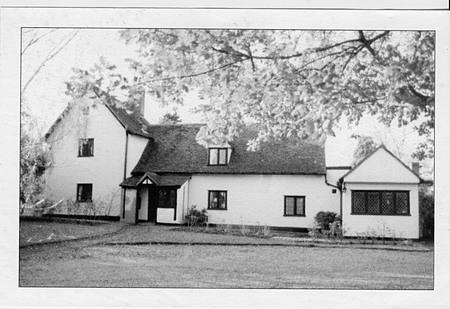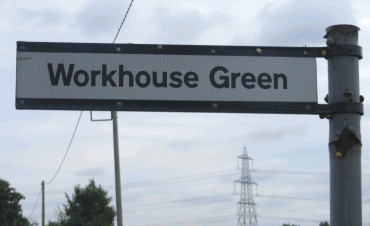|
Unfortunately, no definitive evidence has
been found to indicate where the Workhouse was actually located.
WORKHOUSE - 1820:- First mention
of the workhouse was when Hannah Laysell gave birth to a bastard male
child on May 31st
William Causton was engaged as "Keeper"
or "Master" of the Little Cornard workhouse on 15th March 1806.
Strangely, Causton was only a labourer so why he was given this position
is unknown. He was proposed by William Mumford(Church Warden), Newman
Sparrow(Church Warden) John Larkin (Overseer of the Poor) and Abraham
Griggs (Overseer of the Poor)
One recorded incident in the Parish Workhouse,
was when Hannah Laysell gave birth to a illegitimate male child on May
31st 1820
Although the records (see above) indicate
John Larkin as the "Overseer of the Poor" during 1806, a "John
Constable" was Overseer during 1821 and 1822.
This John Constable was a relation of John Constable(RA) the artist, he
owned numerous properties and pieces
of land in Little Cornard.
Documentary evidence show the workhouse
was in existence until at least 1831.
The "Poor Act" came into force in 1834, this would have seen
its permanent closure and removal of residents to Sudbury
The inventory consisted of 12 beds and
a homely description of a brewhouse, two coppers and wearing apparel consisting
of:-
46 pair stockings
23 pair shoes
15 gowns
15 mantles
4 waistcoats
4 coats
4 pairs of breeches
4 new handkerchiefs
Causton had to additionally provide sufficient,
meat, drink, washing, clothing, repairing and mending thereof and to present
his bills to the Vestry meeting on the first Tuesday of every month. He
was allowed 3/- per week to keep each inmate.
The Workhouse is listed as having
a capacity of 14 inmates.
The inmates of Caustons Workhouse,
may well been impoverished and infirm but they had stunning views over
the Stour Valley towards Henny and the barges which passed along the river.
With a capacity of 14 inmates and 12 beds this would have seen the paupers
possibly having their own single bed. Other workhouses in the area have
inmates 2 or 3 to a bed.
Although records show Causton taking charge
of the Workhouse in 1806, another reference gives a date of its existence
before 1776. So was Causton the first Master or did he take over
from someone else ?
Bury Records Office unfortunately list no names apart from Causton
living at the Workhouse
Interestingly the 1841 census documents
a Causton Family but no sign of William Causton ?
Joseph Cawston 68 Ag. lab. born 1773
Martha Cawston 71 born 1770
Edward Cawston 35 Ag. lab. born 1806
Mary Cawston 12 born 1829
Eliza Cawston 7 born 1834
Joseph Cawston 10 born 1831
|
|
|
 |
However during my research the above
two photographs came to light. A property at the top of Spout Lane,
may have been the Workhouse but the owner has no definitive proof.
Left:- Possible Workhouse dated
late 1900
(Location withheld)
10.10.2010
|
|
Notes the location of the Workhouse
from the Lt Cornard Recorder
Re the Workhouse. Both places Slough
Hall and Stakers were a row of cottages. Constable's brother who's
house was in Spout Lane had a farm which ran 'up to the workhouse'.
This was clearly documented on the deeds of his house.
Constable owned land on either side
of the Road and Slough Hall is along Slough (Slushy) Lane on the
other side of Spout Lane.
At the moment we have no proof for either except that we have found
an old gentleman living in "a cottage" somewhere along
Slough lane in a census and it appears to be part of the workhouse.
We also think that the village workhouses could have been a number
of empty cottages at that time.
Courtesy of
The Little Cornard History
Group
|
|
Little
Cornard Workhouse Records dated 1821
In 1821, three shillings in the pound according to the worth of
your property was paid half yearly to the overseer of the workhouse
for the relief of the poor of the parish. (Although it doesn't always
appear to have worked that way)
Some of the entries for that half
year are below.
NAME PAID PROPERTY VALUE
Robert Canham £4.19s 0d £33.0.d
? Bell £1.19.0d £13.0.d
John Constable £3.0.0d £20.0.d
William Mumford £17.05.0d.
£115.0d
Newman Sparrow £11.6.6d £75.10.0d
John Gurdon Esq £3.7.6d £22.10d
John Stanton £0.6.0d £2.0.0d
Nathanial Taylor £5,0.0d £35.0.0d
and for the STONE £1.15.3d £11.15.0d
and for the MOORS £1.14.6d £11.10.0d
John Sparrow £0.6.0d £2.0.0d
and for 'Canhams' £0.13.6d £4.10.0d
and for 'Stantons' £0.3.0d £1.0.0d
Ruth Bell £0.1.6d £0.10.0d
A rate was also made for the 5th
day of November 1821 for the Necessary Relief of the poor and other
purposes in the several Acts of Parliament relating to the poor
of the Paris of Little Cornard in the County of Suffolk to collect
3 shillings in the pound being the first rate for the winter half
year by me John Constable - Overseer.
Newman Sparrow was also an overseer
for a six month period.
In 1822 the payment had gone up to
4s and 6d and was to be paid on February 4th.
There were no summer accounts with this document.
All accounts were approved after
3 months by Newman Sparrow and Henry Jones -Church Wardens, John
Constable and Newman Sparrow who were overseers and J.Newman Sparrow
and William Mumford who were inhabitants of the village.
Abraham Bell was Overseer from 1814
- Easter 1815.
Courtesy of The Little Cornard
History Group
|
Tenants:-
During the time when Eglington Francis owned the farm a gentleman named
Toogood, a photographer, lived at Stakers.
In about 1938 the three cottages were sold
to Mr and Mrs Panther who carried out alterations. T
hey also bought a piece of extra land at the rear.
In 1944 it was sold to a Mr and Mrs Leighton,
in 1953 to Mr and Mrs Weir and in 1963 to Mr and Mrs Leggett.
Acknowledgment to:-
"Heart of our History" by Ashley Cooper
"At the Overseers Door" by Ray Whitehead
Mr R Shaw , Lt Cornard
Bury RO
Victoria.Shennan. Lt Cornard PC
Eileen King and The Little Cornard History Group
|

